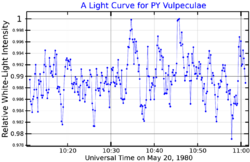Astronomy:G 185-32
From HandWiki
Short description: White dwarf in the constellation Vulpecula
| Observation data Equinox J2000.0]] (ICRS) | |
|---|---|
| Constellation | Vulpecula |
| Right ascension | 19h 37m 13.7502s[2] |
| Declination | +27° 43′ 18.7366″[2] |
| Apparent magnitude (V) | 13.00[3] |
| Characteristics | |
| Spectral type | DA4.0[4] |
| Apparent magnitude (J) | 13.183±0.023[5] |
| Apparent magnitude (H) | 13.213±0.029[5] |
| Apparent magnitude (K) | 13.329±0.043[5] |
| B−V color index | 0.17 |
| Variable type | ZZA[3] |
| Astrometry | |
| Proper motion (μ) | RA: 439.597±0.044[2] mas/yr Dec.: 21.270±0.049[2] mas/yr |
| Parallax (π) | 54.7742 ± 0.0288[2] mas |
| Distance | 59.55 ± 0.03 ly (18.257 ± 0.010 pc) |
| Absolute magnitude (MV) | 11.66 |
| Details[6] | |
| Mass | 0.64±0.10 M☉ |
| Radius | 0.0120±0.0006 R☉ |
| Surface gravity (log g) | 8.09±0.05 cgs |
| Temperature | 12381±186 K |
| Other designations | |
| Database references | |
| SIMBAD | data |
| ARICNS | data |
G 185-32, also known by the variable star designation PY Vulpeculae, is a white dwarf in the constellation Vulpecula. Located approximately 18.3 parsecs (60 ly) distant,[2] the stellar remnant is a ZZ Ceti variable, varying by 0.02 apparent magnitudes from the mean of 13.00.[3]
Observational history
This star was first noticed during a survey for high proper motion stars by Henry L. Giclas, at Lowell Observatory, who listed it as a suspected white dwarf.[7] The white dwarf designation was confirmed spectroscopically in 1970 by astronomer Jesse L. Greenstein of the California Institute of Technology.[8]
References
- ↑ McGraw, J. T.; Fontaine, G.; Dearborn, G. S. P.; Gustafson, J.; Lacombe, P.; Starrfield, S. G. (November 1981). "Two new variable white dwarfs : G 185-32 and G 191-16". The Astrophysical Journal 250: 349–354. doi:10.1086/159381. Bibcode: 1981ApJ...250..349M. https://ui.adsabs.harvard.edu/abs/1981ApJ...250..349M. Retrieved 26 May 2022.
- ↑ 2.0 2.1 2.2 2.3 2.4 2.5 Brown, A. G. A. (August 2018). "Gaia Data Release 2: Summary of the contents and survey properties". Astronomy & Astrophysics 616: A1. doi:10.1051/0004-6361/201833051. Bibcode: 2018A&A...616A...1G. Gaia DR2 record for this source at VizieR.
- ↑ 3.0 3.1 3.2 VSX (4 January 2010). "PY Vulpeculae". AAVSO Website. American Association of Variable Star Observers. http://www.aavso.org/vsx/index.php?view=detail.top&oid=38498. Retrieved 19 October 2014.
- ↑ Gianninas, A. et al. (2011). "A Spectroscopic Survey and Analysis of Bright, Hydrogen-Rich White Dwarfs". The Astrophysical Journal 743 (2): 138. doi:10.1088/0004-637X/743/2/138. Bibcode: 2011ApJ...743..138G.
- ↑ 5.0 5.1 5.2 Skrutskie, Michael F.; Cutri, Roc M.; Stiening, Rae; Weinberg, Martin D.; Schneider, Stephen E.; Carpenter, John M.; Beichman, Charles A.; Capps, Richard W. et al. (1 February 2006). "The Two Micron All Sky Survey (2MASS)". The Astronomical Journal 131 (2): 1163–1183. doi:10.1086/498708. ISSN 0004-6256. Bibcode: 2006AJ....131.1163S. Vizier catalog entry
- ↑ Bédard, A. et al. (2017). "Measurements of Physical Parameters of White Dwarfs: A Test of the Mass–Radius Relation". The Astrophysical Journal 848 (1): 11. doi:10.3847/1538-4357/aa8bb6. Bibcode: 2017ApJ...848...11B.
- ↑ Giclas, Henry L. et al. (1966). "Lowell proper motions VIII : proper motion survey of the Northern Hemisphere with the 13-inch photographic telescope of the Lowell Observatory". Lowell Observatory Bulletin 6 (132): 233–247. Bibcode: 1966LowOB...6..233G.
- ↑ Greenstein, Jesse L. (1970). "Some New White Dwarfs with Peculiar Spectra. VI". Astrophysical Journal Letters 162: L55–L59. doi:10.1086/180622. Bibcode: 1970ApJ...162L..55G.
 |


